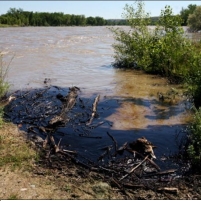Montana Gov. Says ExxonMobil Claim of Limited Spill Damage Is "Pretty Silly"
Wednesday, July 06, 2011

When oil started gushing from an ExxonMobil pipeline into the famed Yellowstone River over the weekend, Montana Governor Brian Schweitzer took exception to the oil company’s initial claim that the spill had not impacted wildlife along the famed Yellowstone River.
“For somebody to say at this early stage that there’s no damage to wildlife, that’s pretty silly,” Schweitzer told the media, adding it was imperative to closely inspect the river as soon as possible to assess the effects of the spill.
Schweitzer’s comment was dismissive of the energy giant named “Green Company of the Year” in 2009 by Forbes Magazine. But memories persist of the 1989 Exxon Valdez tanker spill that dumped more than 250,000 barrels of crude oil in Alaska’s Prince William Sound, and the scandal over the ensuing cleanup and years of litigation that followed.
A pipeline running beneath the Yellowstone River ruptured late Friday, dumping an estimated 42,000 gallons of crude oil into the waterway. Gary Pruessing, president of ExxonMobil’s pipeline operation, tried to assuage public concerns over the spill, claiming most of the damage was limited to a 10-mile stretch of river. The company’s attempts at damage control were undercut by photos from local media sources showing pelicans and turtles coated with oil.
Five days later, ExxonMobil was still scrambling to add workers and finds ways to soak up the goo. And the governor hadn’t changed his tune. “My biggest concern is those 1,000 barrels,” Schweitzer said while declaring a state of emergency. “You cannot dump (that much oil) into a pristine trout stream without causing damage to the fisheries.” The Yellowstone River eventually connects with the larger Missouri River.
On Tuesday, ExxonMobil’s Pruessing was saying oil had flowed 25 miles from the pipeline rupture. But Schweitzer said in his emergency declaration that oil had been found 90 miles away.
It’s not just the fisheries that are endangered. Farmland is being coated with oil as historically high water levels and rapid currents complicate efforts to contain the contamination. Ronald Kendall, chairman of the department of environmental toxicology at Texas Tech University, warned: “It's a very significant amount of oil moving downstream right now, and oil is a toxic substance in itself. A whole suite of organisms, from mink to herons to sturgeon to dragonflies, are going to be affected as waves of oil come through.”
The ruptured pipeline was temporarily shut down in May because of rising waters on the Yellowstone. ExxonMobil decided to reopen the line after it was determined there was little risk of failure.
The pipeline, however, was the subject of seven safety violations uncovered last year by the U.S. Department of Transportation. In light of the spill, Schweitzer promised that all oil and gas pipelines that cross waterways in the state will be inspected and, if necessary, shut down for repairs.
-Noel Brinkerhoff, Ken Broder
Exxon Claims Spill Damage Limited, Gov. Doubtful (by Matthew Brown, Associated Press)
Oil Spill Outrages Montana Residents (by Molly Hennessy-Fiske, Los Angeles Times)
Exxon Oil Spill in Montana’s Yellowstone River Puts Spotlight Back on Pipeline Safety (by David O. Williams, The Colorado Independent)
Crude: Residents Sickened and Ranches and Farms Soaked with Oil from Exxon Yellowstone River Spill (Daily Mail)
Exxon Valdez (A Global Challenge)
- Top Stories
- Unusual News
- Where is the Money Going?
- Controversies
- U.S. and the World
- Appointments and Resignations
- Latest News
- Trump Changes Name of Republican Party
- The 2024 Election By the Numbers
- Bashar al-Assad—The Fall of a Rabid AntiSemite
- Trump Announces He Will Switch Support from Russia to Ukraine
- Americans are Unhappy with the Direction of the Country…What’s New?






Comments